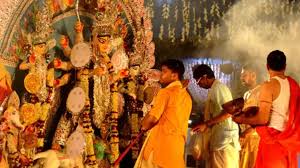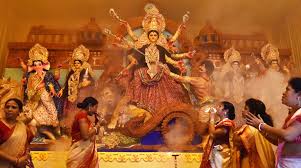

India, a land woven with diverse cultures and traditions, is a vibrant tapestry of festivals that reflect the nation’s rich heritage. Among these, the Durga Puja festival holds a special place, celebrating the divine feminine and the triumph of good over evil. This grand celebration, also known as Navaratri or Durga Puja, is an awe-inspiring spectacle that resonates throughout the country, filling the air with devotion, joy, and spiritual fervor.
Historical and Cultural Significance: Durga Puja, observed annually in the Hindu month of Ashwin (September-October), commemorates the victory of Goddess Durga over the demon king Mahishasura. According to mythology, Durga, the embodiment of divine energy, was created by the gods to defeat the invincible demon who threatened the cosmos. The festival symbolizes the ultimate power of the goddess and her ability to vanquish the forces of darkness.
Spiritual Reverence and Rituals: Months of meticulous preparations precede the Durga Puja, with artisans crafting exquisite idols of the goddess. The festival kicks off with Mahalaya, a special day when devotees offer prayers to invite the goddess into the idols. The subsequent days witness elaborate rituals, devotional songs, and dance performances. The most awaited moment arrives during ‘Vijayadashami,’ the tenth day, when the idols are immersed in rivers and lakes, signifying the departure of the goddess and the end of her earthly sojourn.
Social Harmony and Unity: Durga Puja transcends religious boundaries, welcoming people from all walks of life to partake in the festivities. The pandals (elaborate temporary structures) showcasing the goddess often depict diverse themes, ranging from socio-political issues to environmental concerns. These artistic expressions serve as a medium to raise awareness, fostering social harmony and unity among communities.
Economic Boost and Cultural Exchange: The festival not only provides a spiritual boost but also stimulates the economy. Local businesses thrive as millions of devotees and tourists flood the streets, contributing significantly to the local economy. Moreover, Durga Puja has become a global cultural phenomenon, attracting tourists from around the world. This cultural exchange enriches the festival, infusing it with diverse perspectives and ideas.
The Joy of Giving: Durga Puja embodies the spirit of giving and philanthropy. Many puja committees organize charitable events, blood donation camps, and food drives, emphasizing the importance of compassion and empathy. This aspect of the festival instills a sense of social responsibility, encouraging individuals to contribute positively to society.
The Cultural Extravaganza: Apart from its religious essence, Durga Puja is a celebration of art and creativity. The festival witnesses a plethora of cultural events, including traditional dances, music performances, and drama shows. Renowned artists and performers often grace the occasion, adding to the grandeur of the festivities. These cultural extravaganzas not only entertain but also preserve and promote India’s rich cultural heritage.
In conclusion, Durga Puja stands as a testament to the cultural diversity and spiritual richness of India. Beyond its religious significance, it serves as a unifying force, bringing people together in the spirit of joy, devotion, and communal harmony. As the grand idols of Goddess Durga are immersed, they leave behind a trail of inspiration, reminding everyone of the enduring power of good over evil and the importance of unity in diversity.